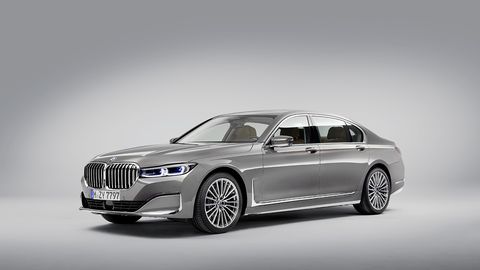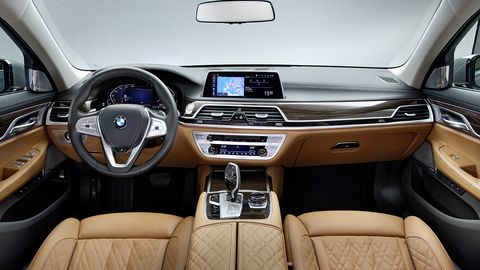The 2020 BMW 7-Series Sedan: Updated luxury
Gallery: 2020 BMW 7-Series: Refreshed luxury

While the company didn’t have a booth at the Detroit auto show, BMW did reveal the 2020 7-Series sedan during the media days of the show — just not in Michigan. The upcoming big Bimmer gets some new styling, updates to its powertrain and some revised high-tech features that should make them more useful and less-like gimmicks.
The 2020 7-Series will offer almost the entire suite of BMW engines: You’ll find a V12, V8 and I6 available in different trims. Of course, the 6.6-liter V12-powered models top the 7-Series trim levels — bearing the 760i badge– and make an impressive 600 hp and 627 lb-ft of torque. The 760i is electronically limited to 155 mph, but we have no doubts that the turbocharged V12 could push past that if the limiter was removed.
If you think the V12 is a little much, you can check off the new-for-2020 V8. The 4.4-liter V8 is good for 523 hp and 553 lb-ft of torque in 750i models. That’s not too much of a horsepower penalty for dropping four cylinders. The V8-powered all-wheel-drive models can still sprint to 60 mph from a dead stop in 3.9 seconds — 0.2 second quicker than the new Toyota Supra.
Stepping closer to the entry point of the 7-Series, the 740i is powered by a 3.0-liter inline-six that churns out 335 hp and 330 lb-ft of torque. While that’s considerably down on power when compared to its V8 and V12 counterparts, the I6-powered 740i xDrive can hit 60 mph in a respectable 4.8 seconds.
Related Story
-

2018 BMW M760i xDrive: Someone will probably be impressed
Oh yeah, and there is a new plug-in hybrid, too. Sporting the 745e badge, the new plug-in hybrid trim expands the line of electrified 7-Series sedans. The 745e blends an electric motor and a straight-six gasoline engine for a combined 389 hp. Torque is up too, over the base model, with the whole system throwing out 442 lb-ft of twist. There will be some all-electric range, as is the case with most plug-in hybrids, but BMW is holding that info until the 745e gets closer to launch.
All of these models send power through a new eight-speed transmission. Even the plug-in hybrid model will use a modified version of the new transmission. From there, power travels to the rear wheels, or into BMW’s xDrive all-wheel-drive system.
Keeping the tires in touch with the road is a double-wishbone front and a five-link rear suspension. Electronically controlled dampers on all four corners give the BMW 7-Series standard adaptive suspension. Air suspension is standard and should make your commute pillow-soft; it can also adjust your ride height by nearly an inch. Making the 7-Series even more comfortable, BMW is offering a system called Active Comfort Drive with Road Preview and active roll stabilization. This system, as the name describes, looks at the road and adjusts the dampers ahead of time and helps load the suspension to reduce roll and vibration.
The BMW 7-Series is no stranger to driver-assistance systems — you can expect the usual fare from BMW: Lane-departure warning, blind-spot monitoring and collision and pedestrian warning with city braking are standard as part of BMW’s Active Driving Assistant package. You can opt for further helpers with the driving assistance professional package that features: adaptive cruise control, extended traffic jam assistant, active lane-keeping assistant with side collision avoidance and automatic lane change, among other features.
Gallery: The 2020 BMW 7-Series interior

You can still add BMW’s night vision on your 7-Series, just in case you live near deer or are chasing down spies. And, BMW is adding automatic parking assisting as standard equipment to let the car park for you — and to free you from your spot when you’re ready to leave.
Wrapping all of this is essentially the same 7-Series as the current model, save for a taller front end, new grille, headlights and revised rear section. BMW also added a new hood with different sculpted contours than the outgoing model. The reshaped rear end features a full-length light strip and wider exhaust surrounds. The new light strip houses three-dimensional LED tail lights.
On the inside — the place where you should spend the most time in your 7-Series — it’s the same level of luxe as the outgoing model, but it’s home to some rethought technology. Simple solutions like moving the wireless charging pad should make the interior more intuitive. While driving, you’ll check the standard 12.3-inch digital instrument cluster to get any information you need to know about how you’re driving. For anything else, you’ll have to check the 10.25-inch Control Display, which is home to your navigation and radio information. BMW says that the hard-drive-based multimedia system can store 20 GB of information and also runs an adaptive navigation system, which means the car should learn your preferred way to head home after a long day at the office. Rounding out the interior is the latest version of BMW’s personal assistant, so your car will respond to you — with varying degrees of success — every time you say “Hey, BMW.”
It’s hard to say if BMW will hike the price or not, but it should be safe to say that it’ll be at least as expensive as the currently available 7-Series. So, expect to pay at least $84,645, or whatever special lease plan your office offers you. You’ll start seeing the refreshed 7-Series this April.

Wesley Wren
Wesley Wren has spent his entire life around cars, whether it’s dressing up as his father’s 1954 Ford for Halloween as a child, repairing cars in college or collecting frustrating pieces of history—and most things in between. Wesley is the current steward of a 1954 Ford Crestline Victoria, a 1975 Harley-Davidson FXE and a 1959 Ford Fairlane 500 Galaxie. Oh yeah, and a 2005 Kia Sedona.






